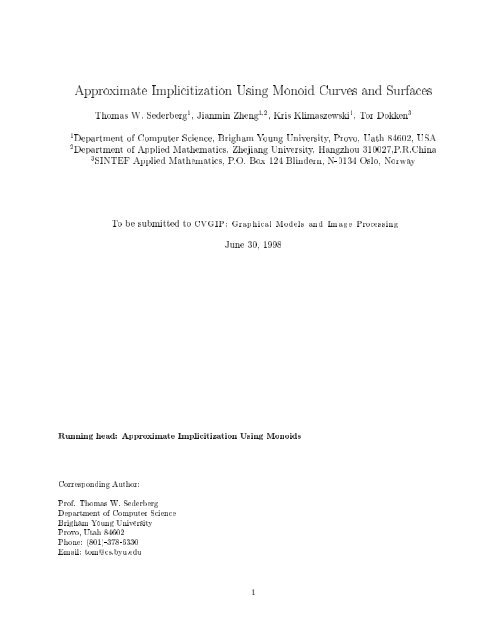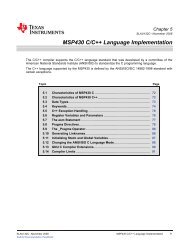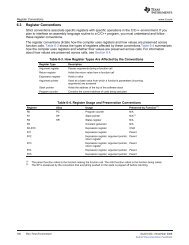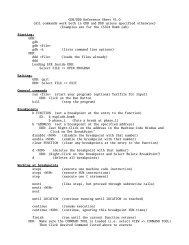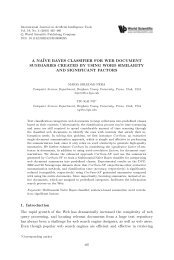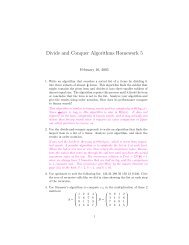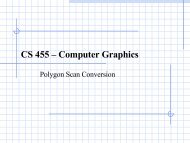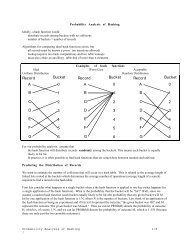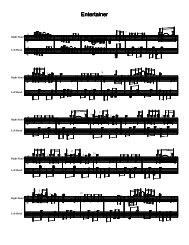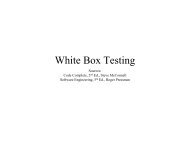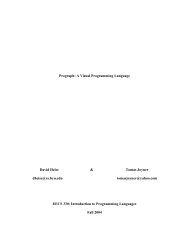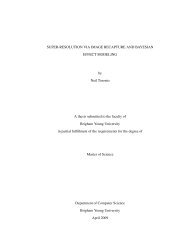Approximate Implicitization Using Monoid Curves and Surfaces
Approximate Implicitization Using Monoid Curves and Surfaces
Approximate Implicitization Using Monoid Curves and Surfaces
Create successful ePaper yourself
Turn your PDF publications into a flip-book with our unique Google optimized e-Paper software.
<strong>Approximate</strong> <strong>Implicitization</strong> <strong>Using</strong> <strong>Monoid</strong> <strong>Curves</strong> <strong>and</strong> <strong>Surfaces</strong><br />
Thomas W. Sederberg 1 , Jianmin Zheng 1;2 , Kris Klimaszewski 1 ,Tor Dokken 3<br />
1 Department of Computer Science, Brigham Young University, Provo, Uath 84602, USA<br />
2 Department of Applied Mathematics, Zhejiang University, Hangzhou 310027,P.R.China<br />
3 SINTEF Applied Mathematics, P.O. Box 124 Blindern, N-0134 Oslo, Norway<br />
To besubmitted to CVGIP: Graphical Models <strong>and</strong> Image Processing<br />
June 30, 1998<br />
Running head: <strong>Approximate</strong> <strong>Implicitization</strong> <strong>Using</strong> <strong>Monoid</strong>s<br />
Corresponding Author:<br />
Prof. Thomas W. Sederberg<br />
Department of Computer Science<br />
Brigham Young University<br />
Provo, Utah 84602<br />
Phone: (801)-378-6330<br />
Email: tom@cs.byu.edu<br />
1
Abstract<br />
This paper presents an approach to nding an approximate implicit equation <strong>and</strong> an approximate inversion<br />
map of a planar rational parametric curve or a rational parametric surface. High accuracy of the<br />
approximation is achieved with a relatively small number of low-degree curve segments or surface patches.<br />
By using monoid curves <strong>and</strong> surfaces, the method eliminates the undesirable singularities <strong>and</strong> \phantom"<br />
branches, normally associated with implicit representation. The monoids are expressed in exact implicit <strong>and</strong><br />
parametric equations simultaneously, <strong>and</strong> upper bounds are derived for the approximate errors of implicitization<br />
<strong>and</strong> inversion equations.<br />
Keywords: <strong>Implicitization</strong>, inversion map, approximation, monoid.<br />
2
1. Mathematical Operators<br />
List of Symbols<br />
p min 6= P<br />
,<br />
jj jj ! max <br />
n<br />
i<br />
p<br />
b c 2 j j [ ] r<br />
2. Greek Characters <strong>and</strong> other symbols<br />
<br />
! o e<br />
P<br />
, n<br />
ijk<br />
, n<br />
ijkl<br />
<br />
<br />
<br />
3. Blackface characters<br />
I P p s x r R b<br />
4. Characters may have superscripts<br />
(1 , u) v u (1 , u 1 ) (Db)<br />
(1 , v) x x y t (1 , v 1 ) D<br />
(1 , t) h s (1 , ) (m +1)<br />
[T , 1 , T 0 ;T 2 , T 0 ] [T , 1 , T 0 ;T 2 , T 0 ;T 3 , T 0 ]<br />
5. Characters may have subscripts<br />
t T c<br />
v P ! u w f<br />
P s x y jj jj<br />
z Q b M a <br />
P<br />
6. Symbols may have subscripts <strong>and</strong> superscripts<br />
B !<br />
7. Symbols in superscripts may be Arabic numerals <strong>and</strong> the following<br />
i j nm k (m)<br />
n l km n,1<br />
I<br />
(m+1)(m+2)<br />
2 ,1<br />
(m+1)(m+2)(m+3)<br />
6 ,1 b 1 6<br />
p<br />
9+12m 3 +72m 2 +132m, 1 2 c<br />
8. Symbols in subscripts may be Arabic numerals <strong>and</strong> the following<br />
I i 00n ijk ijk0 i,1;j;k;1<br />
b n00 nm i;j,1;1 i;j;k,1;1<br />
j 0n0 ijk1 i;j,1;k;1 i,1;j;1<br />
P ij0 ij i;j;k;0 n,i;i,1;1<br />
t Q ij1 ijkl n,i;i;0 n,1,i;i;1<br />
3
1 Introduction<br />
Parametric <strong>and</strong> implicit representations are two main forms for curves <strong>and</strong> surfaces in CAGD [13].<br />
Each<br />
representation has its own advantages. The availability of both often results in simpler computer graphics <strong>and</strong><br />
geometric modeling algorithms [4, 14, 15,21].<br />
Classic algebraic geometry reveals that each parametric curve <strong>and</strong> surface has an implicit representation,<br />
while the converse is not true [23]. The process of converting the parametric equation into the implicit form<br />
is called implicitization. Many techniques, such as the resultant-based method [20], Grobner basis method [5],<br />
<strong>and</strong> moving curve <strong>and</strong> surface methods [22], have been developed to implicitize parametric curves <strong>and</strong> surfaces.<br />
However, implicitization (especially surface implicitization) has not found widespread use in geometric modeling.<br />
This is in part due to the fact that the surface implicitization process is relatively complicated <strong>and</strong> the<br />
degree of the implicit surface equation high. Another diculty is that a single implicitized parametric curve<br />
or surface may have unwanted components or self-intersections. Figure 1a shows a cubic Bezier curve with the<br />
control polygon, <strong>and</strong> Figure 1b shows the implicitized curve with a double point. Figure 2 shows a quartic<br />
Bezier curve <strong>and</strong> its implicit curve, which includes an extraneous curve segment in the neighborhood of the<br />
Bezier curve. These undesirable extraneous singularities <strong>and</strong> branches often lead to computational instability<br />
<strong>and</strong> topological inconsistency in geometric modeling, thus limiting the usefulness of implicitization.<br />
T 0<br />
P 3<br />
P 0<br />
T 1<br />
P 1<br />
P 2 T 2<br />
Figure 1: a). Cubic Bezier curve <strong>and</strong> its control polygon; b). Implicit curve with a double point.<br />
For these reasons, approximate implicitization has been proposed [6, 9,25]. Montaudouin <strong>and</strong> Tiller employed<br />
apower series method to obtain local explicit approximations || about a regular point || to polynomial<br />
4
P 0<br />
T 0<br />
T 1<br />
T 2<br />
P 1<br />
P 4<br />
P2<br />
P 3<br />
Figure 2: a). Quartic Bezier curve <strong>and</strong> its control polygon; b). Implicit curve with a \phantom" branch.<br />
parametric curves <strong>and</strong> surfaces [9]. This approach is asymmetric as one variable is made an explicit function of<br />
the other(s). Chuang <strong>and</strong> Homann extended this method using what they call \implicit approximation" [6].<br />
Alow-degree implicit equation is computed to locally approximate a properly|parametrized rational curve or<br />
surface. In this way one can obtain the exact implicit form if the approximant is of the same degree as the implicit<br />
form. Dokken proposed a new way toapproximate the parametric curve <strong>and</strong> surface \globally" in the sense<br />
that the approximation is valid within the whole domain of the curve segment or surface patch. An in-depth<br />
investigation of this topic can be found in his dissertation [11]. But, even these approximate implicitization<br />
methods can suer from the problems illustrated in Figures 1 <strong>and</strong> 2. To circumvent these diculties, algorithms<br />
based on monotonicity <strong>and</strong> least-squares approximation can be invoked [2, 7,8,12] <strong>and</strong> certain constraints on<br />
the coecients of the implicit representation [1, 3, 18, 19]have been introduced.<br />
This paper most closely extends Dokken's work to approximate implicitization as well as approximate inversion<br />
map, <strong>and</strong> proposes employing monoid curves <strong>and</strong> surfaces to compute a low-degree approximant. This<br />
allows us to overcome the two problems mentioned earlier. Moreover, monoids have another advantage in that<br />
they possess both exact implicit <strong>and</strong> parametric representations.<br />
The paper is organized as follows. Section 2 reviews some of Dokken's approximate implicitization results.<br />
In section 3, we present the development of the monoid curve scheme, including the dual representation of the<br />
monoid curve, approximate implicitization, approximate inversion map <strong>and</strong> error analysis. Section 4 describes<br />
monoid surface case. Examples <strong>and</strong> some observations are given in section 5.<br />
5
2 <strong>Approximate</strong> implicitization method<br />
Dokken developed a general method to approximately implicitize g-manifolds represented by parametric equations<br />
[11]. Here, we outline his approach.<br />
Let p(s) be a parametric || say, Bezier || curve or surface. We would like to nd an approximate<br />
low-degree implicit equation q(x) =0forp(s). In general, the distance between the parametric curve or surface<br />
<strong>and</strong> its implicit approximation depends not only on the value of q p(s), but also on the gradient of q(x).<br />
However, in practice, the value of jq p(s)j alone can serve as a measure of the goodness of an approximation,<br />
provided the coecients of q are normalized. This reduces the implicitization problem to nding a degree m<br />
algebraic hypersurface q(x) =0with normalized coecients such that jq p(s)j, where is a prescribed<br />
tolerance.<br />
Let S be an arbitrary simplex containing p(s), <strong>and</strong> q(x) = P I b I m!<br />
I! xI be represented in barycentric coordinates<br />
x over S. Then the composition of q(x) = 0 <strong>and</strong> p(s) can be expressed as<br />
q p(s) =(Db) T (s); (1)<br />
where D is a constant matrix, called composite matrix, b is a vector consisting of the coecients of q, <strong>and</strong> (s)<br />
is a vector whose components are basis functions of the composition.<br />
If the components of (s) form a unit partition for s 2 , the following properties hold:<br />
Property 1. max<br />
s2<br />
jq p(s)jkDbk 2<br />
Property 2.<br />
min<br />
kbk 2=1<br />
kDbk 2 = 1 , where 1 0 is the smallest singular value of D.<br />
Thus we can obtain q(x) by setting b to the eigenvector of D D that corresponds to the eigenvalue 2 1 . This<br />
will ensure q(x) satises jq p(s)j when 1
Example 2.1. Let C(v) =(x(v)=w(v);y(v)=w(v));<br />
8<br />
<<br />
:<br />
v 2 [0; 1] be a degree 8 rational curve:<br />
x(v) = 52:7v , 8 237:8v 7 + 445:5v , 6 447:4v 5 + 273:8v , 4 117:6v 3 +28v 2 +8:8v , 2:2<br />
y(v) = ,29:8v 8 +96:7v , 7 122:9v 6 +68:3v 5 +4:9v , 4 38:6v 3 +36:7v , 2 11:4v +0:6<br />
w(v) = 2:9v , 8 7:2v 7 +16:8v , 5 21v 4 +11:2v , 3 2:8v 2 +1:1<br />
<strong>and</strong> S(u; v) =(,0:08u 3 v 3 +0:33u 2 v 3 +0:24u 3 v +0:48u , 3 0:99u v, 2 0:25v , 3 1:98u 2 +0:75v +1:5;,0:08u 3 v ,<br />
3<br />
0:09u 2 v 3 +0:24u 3 v +0:42uv 3 +0:48u 3 +0:27u 2 v +0:54u 2 , 1:26uv , 2:52u; 0:075v 3 , 1:57v +2:4) be a bicubic<br />
patch. We compute the approximate implicitization using degree 3 algebraic curves <strong>and</strong> surfaces. We also<br />
subdivide the curve <strong>and</strong> the surface, <strong>and</strong> process the approximate implicitization for each sub-segment <strong>and</strong><br />
sub-patch. The absolute values of the compositions <strong>and</strong> the approximation errors are shown in Table 1.<br />
subdivision Curve Surface<br />
level jq C(v)j Dist jq S(u; v)j Dist <br />
0 3 10 ,4 1 10 ,2 1:610 ,5 2:3 10 ,4<br />
1 8 10 ,6 7 10 ,5 7:810 ,6 4:1 10 ,5<br />
2 6 10 ,8 5 10 ,7 1:310 ,6 2:8 10 ,6<br />
Table 1: Approximation errors by algebraic curves <strong>and</strong> surfaces.<br />
3 <strong>Monoid</strong> curves<br />
Since curves are conceptually <strong>and</strong> notationally simpler <strong>and</strong> easier to visualize than surfaces, we begin our<br />
discussion with the former.<br />
A degree n algebraic curve is dened by an implicit equation which is normally written in the st<strong>and</strong>ard<br />
power basis:<br />
f(x; y) = X<br />
i+jn<br />
f ij x i y j =0: (2)<br />
However, it is convenient to express such an equation in Bernstein-Bezier form relative to an arbitrary triangle,<br />
called the curve's reference triangle, in the plane z = 0 using barycentric coordinates (s; t; u):<br />
f(s; t; u) =<br />
X<br />
i+j+k=n<br />
n<br />
c ijk s i t j u k =0; s + t + u 1: (3)<br />
ijk<br />
In this formulation [18], the curve can be viewed as the intersection of the plane z = 0 with the triangular Bezier<br />
surface patch 0<br />
@ x y<br />
z<br />
1<br />
A =<br />
X<br />
i+j+k=n<br />
n<br />
P ijk s i t j u k ; 0 s; t; u 1; s + t + u 1: (4)<br />
ijk<br />
7
The projection of control points P ijk onto the plane z = 0 forms a triangular lattice with the reference triangle's<br />
vertices T 0 , T 1 <strong>and</strong> T 2 corresponding to P 00n , P n00 <strong>and</strong> P 0n0 , respectively. That is,<br />
0 1 0<br />
1<br />
P ijk = @ x ijk<br />
y ijk<br />
A = @ (ix n00 + jx 0n0 + kx 00n )=n<br />
(iy n00 + jy 0n0 + ky 00n )=n A : (5)<br />
z ijk c ijk<br />
Note that the reference triangle bounds the intersection of the triangular surface patch with the plane<br />
z =0. <strong>Using</strong> this formulation, it is possible to represent the algebraic curve segments of interest. However, as<br />
demonstrated in Figures 1 <strong>and</strong> 2, the implicitized parametric curves often have self-intersections <strong>and</strong> undesirable<br />
\phantom" components. Since monoid curves <strong>and</strong> surfaces can easily avoid these problems, our strategy is to<br />
use the monoid representation in lieu of general algebraic curves <strong>and</strong> surfaces.<br />
3.1 Dual representation for monoid curves<br />
An algebraic curve of degree n with a multiple point O of order n , 1was called by Cayley a monoid [24]. If<br />
O is at the original point, the monoid curve equation consists of terms of degree n <strong>and</strong> n , 1 only. The genus<br />
of such a curve is zero, therefore the curve is rational. Also, as any line through O meets the curve in just one<br />
other point, there is a one-to-one correspondence between the points on the curve <strong>and</strong> the pencil of lines with<br />
the axis located at O.<br />
In the Bernstein-Bezier formulation, a monoid curve has a simple representation if we choose one vertex of<br />
the reference triangle to be the multiple point. Let a degree n monoid curve be dened by (3) in the Bernstein-<br />
Bezier form over reference triangle T 0 T 1 T 2 . If we assume T 0 to be the multiple point of the monoid curve, then<br />
c ijk = 0 when k>1 (see Figure 3). Thus the curve equation can be rewritten as<br />
f(s; t; u) =f b (s; t)+uf i (s; t) = X<br />
i+j=n<br />
This is the implicit representation of a monoid curve.<br />
c ij0<br />
n<br />
i<br />
s i t j + un X<br />
i+j=n,1<br />
n<br />
c ij1<br />
,<br />
<br />
1<br />
s i t j : (6)<br />
i<br />
We now derive the parametric representation. Let P (s; t; u) be a point on the monoid curve (see Figure 4).<br />
Line T 0 P will intersect T 1 T 2 at point I, whose coordinates are (s=(1 , u);t=(1 , u); 0). By introducing a new<br />
parameter = t=(1,u), the barycentric coordinates of P can be expressed in terms of <strong>and</strong> u:<br />
s =(1, )(1 , u); t = (1 , u); u = u: (7)<br />
8
T 0<br />
0<br />
T 2<br />
0<br />
0<br />
1.2<br />
2.9<br />
0.9<br />
T 1<br />
-0.4 0.1 0.2 -0.2<br />
Figure 3: Cubic monoid curve with its double point T 0 .<br />
T 0<br />
P(s,t,u)<br />
T 1<br />
I(1−τ,τ,0)<br />
T 2<br />
Figure 4: Parameter of a monoid curve.<br />
Furthermore, since P (s; t; u) lies on the curve, it satises the implicit equation<br />
f b (s; t)+uf i (s; t) =(1, u) n f b (1 , ;)+u(1 , u) n,1 f i (1 , ;)=0: (8)<br />
In consequence, 8><<br />
>:<br />
s =<br />
,(1 , )f i (1 , ;)<br />
f b (1 , ;) , f i (1 , ;) ;<br />
t =<br />
,f i (1 , ;)<br />
f b (1 , ;) , f i (1 , ;) ;<br />
u =<br />
(9)<br />
f b (1 ;)<br />
f b (1 , ;) , f i (1 , ;) :<br />
This represents a rational parametric curve of degree n. The equation can be further rewritten in the Bezier<br />
9
form:<br />
with<br />
0<br />
@ s t<br />
u<br />
1 P n<br />
A =<br />
i=0<br />
nP<br />
i=0<br />
w i Q i B n i ()<br />
the weights w i = c n,i;i;0 , ic n,i;i,1;1 , (n , i)c n,1,i;i;1<br />
<strong>and</strong> the control points Q i =<br />
w i B n i () (10)<br />
0<br />
@ ,(n , 1<br />
i)c n,1,i;i;1<br />
,ic n,i;i,1;1<br />
c n,i;i;0<br />
A =wi :<br />
If the weights are all non-negative or all non-positive <strong>and</strong> w 0 w n 6=0,wesay that the coecients c i;j;k satisfy<br />
the \same-sign" condition. Under this condition, the monoid curve has many useful properties, one of which is<br />
convex hull property.<br />
Finally, it follows from the above derivation that the inversion map of the monoid curve is a linear fractional<br />
transformation<br />
3.2 <strong>Approximate</strong> implicitization <strong>and</strong> inversion map<br />
= t=(1 , u): (11)<br />
Given a planar degree n rational Bezier curve<br />
p(v) =<br />
nP<br />
i=0<br />
nP<br />
i=0<br />
! i P i B n i (v)<br />
! i B n i (v) ; v 2 [0; 1]; (12)<br />
where P i are the control points, ! i the weights <strong>and</strong> Bi n(t) =, n<br />
i<br />
(1 , t) n,i t i ,wewant to nd a monoid curve<br />
q() = 0 to approximate the parametric curve. The process of approximate implicitization involves the following<br />
steps.<br />
1. Determine the reference triangle for the monoid curve.<br />
To dene an algebraic curve, an arbitrary triangle can be used as the reference triangle. Dokken showed<br />
that the numerical stability of the approximation process benets from choosing a bounding triangle as the<br />
reference triangle. However, for a monoid curve one vertex of the reference triangle must be the multiple<br />
point ifwe express the curve as in (6). When a monoid curve is used to approximate a parametric curve<br />
segment, the location of the multiple point has a signicant impact on the accuracy of the approximation.<br />
As an example, Figure 5 demonstrates the relationship between the maximum approximation error <strong>and</strong><br />
the location of the multiple point for a cubic Bezier curve.<br />
10
T 0 =M 0 T 0 =M 1<br />
P 0 P 3<br />
P 0 P 3<br />
T 1 T 2 T 1<br />
T 2<br />
P 1<br />
P 2<br />
P 1<br />
P 2<br />
P 1 P 2<br />
M<br />
P 1 P 2<br />
M 2<br />
P 0 P 3<br />
P 0<br />
P 3<br />
Figure 5: An example of the relationship between the approximation error <strong>and</strong> the location of the multiple<br />
point for a cubic Bezier curve. The errors for the top-left, top-right <strong>and</strong> bottom-left approximations are 0.0,<br />
0.02, 0.06. The bottom-right gure shows error iso-contours: if T 0 is placed at any point on a contour line, the<br />
approximation error is unchanged.<br />
While sampling discretely for the optimal multiple point might give good results, such a search would be<br />
computationally expensive. An ecient method of nding the optimal reference triangle (i.e., one that<br />
gives the smallest approximation error) is yet to be devised. In the interim, we determine the reference<br />
triangle, as shown in Figure 6.<br />
First, an oriented bounding box ABCD is computed using a method<br />
proposed in [16, 26]. Then we nd the \concave" side of the curve segment within that bounding box.<br />
(This can be done, somewhat roughly, by classifying the endpoints of the curve segment, P 0 <strong>and</strong> P 1 , with<br />
respect to that axis of symmetry of the bounding box, a 1 , that is parallel to the AB direction.) Next, the<br />
11
multiple point T 0 is chosen such that it lies on the \concave" side of the curve <strong>and</strong> on the other axis of<br />
symmetry a 2 . Finally, the other vertices of the reference triangle, T 1 <strong>and</strong> T 2 , are found as the intersections<br />
between the bounding box's base DC <strong>and</strong> the lines joining the corners A <strong>and</strong> B with T 0 .<br />
T 0<br />
T 2<br />
|AB|<br />
A<br />
P 0<br />
P 3<br />
P 2<br />
P 4<br />
P1<br />
T 1<br />
C<br />
D<br />
B<br />
a 1<br />
a 2<br />
Figure 6: Reference triangle determination.<br />
2. Convert the parametric curve p(v) into barycentric form.<br />
Let T 0 T 1 T 2 be the reference triangle with T 0 as its multiple point. Then arbitrary point P can be converted<br />
into barycentric form<br />
P =<br />
x<br />
y<br />
<br />
= sT 1 + tT 2 + uT 0 = T 0 +[T 1 , T 0 ;T 2 , s<br />
T 0 ] ; (13)<br />
t<br />
or 8 <<br />
:<br />
s<br />
t<br />
<br />
= [T 1 , T 0 ;T 2 , T 0 ] ,1 (P , T 0 );<br />
u = 1 , s , t:<br />
For a rational Bezier curve, the conversion can be completed simply by applying transformation (14) to<br />
each control point P i . The converted curve isnow put in the form<br />
p(v) =<br />
0<br />
@ s t<br />
u<br />
1 P n<br />
A =<br />
i=0<br />
nP<br />
i=0<br />
! i<br />
P i B n i (v)<br />
(14)<br />
! i B n i (v) ; v 2 [0; 1]: (15)<br />
12
3. Combine the implicit equation with the parametric equation.<br />
A monoid curve of degree m is dened over reference triangle T 0 T 1 T 2 by<br />
q(s; t; u) =<br />
X<br />
i+j=m<br />
c ij0<br />
m<br />
i<br />
Let b be a vector consisting of the coecients of q:<br />
s i t j + um X<br />
i+j=m,1<br />
m<br />
c ij1<br />
, 1<br />
s i t j : (16)<br />
i<br />
b =[c m00 ;c m,1;1;0 ;;c 0m0 ;c m,1;0;1 ;c m,2;1;1 ;;c 0;m,1;1 ] : (17)<br />
Substituting the parametric equation p(v) into q leads to<br />
q p(v) =(Db) (v); (18)<br />
in which (v) =[! (m)<br />
0<br />
B nm<br />
0<br />
(v);! (m)<br />
1<br />
B nm<br />
1<br />
(v);;! (m)<br />
nm B nm<br />
nm (v)] = P nm<br />
(v), <strong>and</strong> D is the composite<br />
matrix of order (mn +1) (2m + 1).<br />
i=0 !(m) i Bi<br />
nm<br />
The entries of D can be evaluated by applying the functional composition algorithms [10]. Since (v)<br />
consists of rational Bernstein polynomials of degree nm, jq p(v)jkDbk 2 .<br />
4. Perform least-squares approximation.<br />
Usually, the equations Db = 0 are over-constrained. Therefore we seek a least-squares non-zero solution.<br />
Let 2 1 be the smallest eigenvalue of D D, <strong>and</strong> b a normalized eigenvector of D D corresponding to 2 1.<br />
Then vector b is a solution, <strong>and</strong> the points on the parametric curve are subject to jq p(v)j 1 .<br />
In many applications, the inversion formula for a parametric curve is needed. The inversion map of a degree<br />
n parametric curve is generally a rational polynomial of degree n , 2. Having found the reference triangle,<br />
we are now in a position to compute an approximate inversion map. To accomplish that, we apply a process<br />
similar to our approximate implicitization scheme. Assume that the approximate inversion map is a rational<br />
polynomial of degree m ( n , 2):<br />
v =<br />
h(s; t; u)<br />
d(s; t; u) : (19)<br />
To determine the coecients of the unknown polynomials h <strong>and</strong> d, we construct a new function<br />
H(s; t; u; v) =h(s; t; u) , vd(s; t; u): (20)<br />
13
A least-squares solution for h <strong>and</strong> d is arrived at by replacing q with H in the steps of our approximate<br />
implicitization method.<br />
3.3 Error estimation<br />
3.3.1 Estimation of the distance from a point to a monoid curve<br />
Given a point P 1 (s 1 ;t 1 ;u 1 ), we nd point P 0 , other than T 0 , at which the monoid curve intersects the line going<br />
through T 0 <strong>and</strong> P 1 (see Figure 7). In order to estimate the smallest distance between P 1 <strong>and</strong> the curve, we<br />
consider the distance from P 1 to P 0 . It is obvious that the former is bounded by the latter.<br />
T 0<br />
T 2<br />
P 0<br />
P 1<br />
T 1<br />
I<br />
Figure 7: Distance between P 1 <strong>and</strong> P 0 .<br />
Assume that the barycentric coordinates of P 0 are (s 0 ;t 0 ;u 0 ) <strong>and</strong> that line T 0 P 1 intersects line T 1 T 2 at<br />
I(1 , ;;0). Hence<br />
= t 1 =(1 , u 1 );<br />
s 0 =(1, u 0 )(1 , ); t 0 =(1, u 0 ); u 0 = u 0 ;<br />
s 1 =(1, u 1 )(1 , ); t 1 =(1, u 1 ); u 1 = u 1 :<br />
Note that point P 0 is on the monoid curve. From the parametric representation (10),<br />
(21)<br />
u 0 = f b (1 , ;)=(f b (1 , ;) , f i (1 , ;)): (22)<br />
The distance between P 1 <strong>and</strong> P 0 is :<br />
kP 1 P 0 k =<br />
k(s 1 , s 0 )T 0 T 1 +(t 1 , t 0 )T 0 T 2 = ju 1 , u 0 jk(1 , )T 0 T 1 + T 0 T 2 k<br />
f<br />
= ju 1 , b (1,;)<br />
f b (1,;),f i(1,;)<br />
jk(1 , )T 0 T 1 + T 0 T 2 k:<br />
(23)<br />
14
3.3.2 Error bound for approximate implicitization<br />
Assume that f(P 1 )= 1 , that is,<br />
f(P 1 )=(1, u 1 ) n,1 [(1 , u 1 )f b (1 , ;)+u 1 f i (1 , ;)] = 1 : (24)<br />
Solving (22) <strong>and</strong> (24), we have<br />
f b (1 , ;)=u 0 1 =[(u 0 , u 1 )(1 , u 1 ) n,1 ]; (25)<br />
which means<br />
u 0 , u 1 =<br />
1<br />
(1 , u 1 ) n,1 (f b (1 , ;) , f i (1 , ;)) : (26)<br />
<strong>Using</strong> degree elevation, we rearrange f b (1 , ;) , f i (1 , ;):<br />
f b (1 , ;) , f i (1 , ;)<br />
P ,<br />
= c n<br />
ij0 i<br />
(1 , ) i j , n<br />
=<br />
P<br />
i+j=n<br />
i+j=n<br />
P<br />
i+j=n,1<br />
(c ij0 , ic i,1;j;1 , jc i;j,1;1 ) , n<br />
,<br />
c n,1<br />
<br />
ij1 i (1 , ) i j<br />
i<br />
(1 , ) i j :<br />
When c ijk satisfy the \same-sign" condition mentioned in Section 3.1, jf b (1,;),f i (1,;)j min<br />
i+j=n jc ij0 ,<br />
ic i,1;j;1 , jc i;j,1;1 j.<br />
We now turn to estimating the distance between the parametric curve p(v) <strong>and</strong> the approximate monoid<br />
curve. For the third component ofp(v) in barycentric form (15),<br />
1 , u(v) =1,<br />
nP<br />
nP<br />
i=0<br />
i=0<br />
! i u i B n i (v)<br />
! i B n i (v) =<br />
nP<br />
i=0<br />
! i (1 , u i )B n i (v)<br />
nP<br />
i=0<br />
(27)<br />
! i B n i (v) : (28)<br />
Since p(v) is located within the reference triangle, 1 , u i > 0 for all i's. When all ! i 's are nonnegative,<br />
j1 , u(v)jmin<br />
i<br />
f1 , u i g.<br />
Consequently, if the above assumptions about coecients c ijk <strong>and</strong> weights ! i hold, an error bound in the<br />
approximate implicitization method from Section 3.2 is given by<br />
D(p(v); monoid curve) <br />
min<br />
i<br />
3.3.3 Error bound for approximate inversion map<br />
1 maxfkT 0 T 1 k;kT 0 T 2 kg<br />
f1 , u i g min jc ij0 , ic i,1;j;1 , jc i;j,1;1 j : (29)<br />
i+j=n<br />
Once an approximate inversion map<br />
v a =<br />
h(s; t; u)<br />
d(s; t; u)<br />
(30)<br />
15
is found, substituting the parametric curve equation (15) into it yields<br />
h(s(v);t(v);u(v)) , vd(s(v);t(v);u(v)) = (v); (31)<br />
where j(v)j 1 , <strong>and</strong> 1 is the smallest singular value of the composite matrix for the composition of H with<br />
the parametric curve. Thus the exact parameter is<br />
v t =<br />
h(s; t; u) , (v)<br />
: (32)<br />
d(s; t; u)<br />
Hence we nd an upper bound on the dierence between the exact <strong>and</strong> approximate parameters:<br />
jv t , v a j = j<br />
(v)<br />
d(s; t; u) j<br />
The value of minjd(s; t; u)j can generally be estimated using the coecients of d.<br />
4 <strong>Monoid</strong> surfaces<br />
j 1 j<br />
minjd(s; t; u)j : (33)<br />
Algebraic surfaces suer from the same problems that algebraic curves do. To remedy these diculties, we<br />
extend the monoid curve scheme to surfaces. Our development parallels that for curves.<br />
4.1 Dual representation for monoid surfaces<br />
A degree n monoid surface has a multiple point O of order n , 1, <strong>and</strong> therefore is rational. For instance, the<br />
Steiner surface is a quartic monoid [21]. Just as in the curve case, a reference tetrahedron can be specied whose<br />
four vertices are denoted by T 0 , T 1 , T 2 <strong>and</strong> T 3 . The surface is expressed in Bernstein-Bezier form:<br />
f(s; t; u; v) =<br />
X<br />
i+j+k+l=n<br />
n<br />
c ijkl s i t j u k v l =0; s + t + u + v 1; (34)<br />
ijkl<br />
where s, t, u <strong>and</strong> v are barycentric coordinates with respect to the tetrahedron, <strong>and</strong> coecients c ijkl<br />
are<br />
associated with the so-called control points P ijkl = i n T 1 + j n T 2 + k n T 3 + l n T 0 (see Figure 8).<br />
When T 0 is the multiple point, c ijkl = 0 for l>1, <strong>and</strong> the implicit equation of the monoid surface becomes<br />
P<br />
f(s; t; u; v) = f b (s; t; u)+vf<br />
, i (s; t; u)<br />
= c n<br />
ijk0 ijk<br />
s i t j u k + vn<br />
i+j+k=n<br />
P<br />
i+j+k=n,1<br />
,<br />
c n,1<br />
<br />
ijk1 ijk s i t j u k : (35)<br />
In order to represent the monoid surface in parametric form, consider an arbitrary point P (s; t; u; v) onthe<br />
surface. Let I be the intersection point of line T 0 P with the plane determined by T 1 , T 2 <strong>and</strong> T 3 . It is easy to<br />
16
T 0 =P 0003<br />
P(s,t,u,v)<br />
T 2 =P 0300<br />
T 3 =P 0030<br />
I(α,β,γ,0)<br />
T 1 =P 3000<br />
Figure 8: Cubic monoid surface.<br />
show that the barycentric coordinates of I are (s=(1 , v);t=(1 , v);u=(1,v); 0). Set<br />
= s=(1 , v); = t=(1 , v); = u=(1,v) (36)<br />
<strong>and</strong> use , <strong>and</strong> as the paramters of the monoid surface<br />
s = (1 , v); t = (1 , v); u = (1 , v); + + 1: (37)<br />
Substituting (37) into (35) yields<br />
f b (s; t; u)+vf i (s; t; u) =(1, v) n f b (; ; )+v(1 , v) n,1 f i (; ; ) =0: (38)<br />
By solving this equation, we obtain the parametric representation for the monoid surface<br />
8<br />
><<br />
>:<br />
s =<br />
,f i (; ; )<br />
f b (; ; ) , f i (; ; ) ;<br />
t =<br />
,f i (; ; )<br />
f b (; ; ) , f i (; ; ) ;<br />
u =<br />
(39)<br />
,f i (; ; )<br />
f b (; ; ) , f i (; ; ) ;<br />
v =<br />
f b (; ; )<br />
f b (; ; ) , f i (; ; ) :<br />
17
Written in triangular Bernstein-Bezier form, it looks like this:<br />
with<br />
0<br />
B<br />
@<br />
s<br />
t<br />
u<br />
v<br />
1<br />
C<br />
A =<br />
P<br />
P<br />
i+j+k=n<br />
i+j+k=n<br />
,<br />
w ijk Q n<br />
<br />
ijk ijk i j k<br />
w ijk<br />
, n<br />
ijk<br />
the weights w ijk = c ijk0 , ic i,1;j;k;1 , jc i;j,1;k;1 , kc i;j;k,1;1<br />
<strong>and</strong> the control points Q ijk =<br />
0<br />
B<br />
@<br />
<br />
i j k (40)<br />
,ic i,1;j;k;1<br />
1<br />
C<br />
A =w ijk:<br />
c i;j;k;0<br />
,jci;j,1;k;1<br />
,kci;j;k,1;1<br />
Similarly, the coecients c ijkl satisfy the \same-sign" condition if the weights w ijk are all non-negative orall<br />
non-positive, <strong>and</strong> the weights at the three corners are nonzero.<br />
4.2 <strong>Approximate</strong> implicitization <strong>and</strong> inversion map<br />
We now consider approximate implicitization for a rational Bezier surface of degree n k with control points<br />
P ij <strong>and</strong> weights ! ij :<br />
p(; ) =<br />
nP kP<br />
i=0 j=0<br />
nP<br />
i=0 j=0<br />
! ij P ij B n i ()Bk j ()<br />
kP<br />
! ij B n i ()Bk j () ; ; 2 [0; 1]: (41)<br />
In general, the implicit degree of p(; ) is 2mk. An approximate monoid surface q() = 0 for this implicit<br />
equation can be found using the following procedure.<br />
1. Determine the reference tetrahedron for the monoid surface.<br />
A method for nding the optimum tetrahedron that ensures maximum numerical stability <strong>and</strong> the best<br />
accuracy remains to be discovered. As of now, we are able to propose only an intuitive way of constructing<br />
the reference tetrahedron, a direct extension of the approach we used to determine the reference triangle<br />
for a curve. Namely, for a given rational parametric Bezier patch, we compute an oriented bounding box<br />
<strong>and</strong> nd the \concave" side of the patch. The multiple point is chosen on that side. The other three<br />
vertices are determined on the base plane of the bounding box such that the tetrahedron contains the box.<br />
Since the construction is similar to that for curves, we omit further details.<br />
2. Convert the parametric surface p(; ) into barycentric form.<br />
18
If T 0 T 1 T 2 T 3 is the reference tetrahedron, then an arbitrary point P can be converted into barycentric form<br />
P =<br />
0<br />
@ x y<br />
z<br />
1<br />
or 8<br />
> <<br />
A = sT1 + tT 2 + uT 3 + vT 0 = T 0 +[T 1 , T 0 ;T 2 , T 0 ;T 3 , T 0 ]<br />
>:<br />
0<br />
@ s t<br />
u<br />
1<br />
A = [T1 , T 0 ;T 2 , T 0 ;T 3 , T 0 ] ,1 (P , T 0 );<br />
v = 1 , s , t , u:<br />
0<br />
@ s t<br />
u<br />
1<br />
A ; (42)<br />
Applied to each control points of p(; ), this transformation produces the surface equation in barycentric<br />
(43)<br />
form:<br />
p(; ) =<br />
0<br />
B<br />
@<br />
s<br />
t<br />
u<br />
v<br />
1 P n C<br />
A = i=0<br />
kP<br />
j=0<br />
nP<br />
i=0 j=0<br />
! ij<br />
P ij B n i ()Bk j ()<br />
kP<br />
! ij B n i ()Bk j () : (44)<br />
3. Combine the implicit equation with the parametric equation.<br />
A degree m monoid surface dened over reference tetrahedron T 0 T 1 T 2 T 3 with multiple point T 0 is expressed<br />
by<br />
q(s; t; u; v) =<br />
X<br />
i+j+k=m<br />
m<br />
c ijk0<br />
ijk<br />
s i t j u k + vm<br />
X<br />
i+j+k=m,1<br />
m<br />
c ijk1<br />
, 1<br />
s i t j u k : (45)<br />
ijk<br />
Let b be a vector of the unknown coecients c ijkl , <strong>and</strong> (; )avector consisting of the rational polynomial<br />
basis ! (m)<br />
ij<br />
Bi<br />
nm ()Bj<br />
km ()= nm P km P<br />
! (m)<br />
ij<br />
Bi<br />
nm ()Bj km (). The composition of q <strong>and</strong> p(; ) can now be<br />
arranged into<br />
i=0 j=0<br />
q p(; ) =(Db) (; ): (46)<br />
Matrix D is of order (mn+1)(km+1)(m+1) 2 . We compute its entries using the functional composition<br />
algorithm [10]. Note that q() satises the inequality jq p(; )jkDbk 2 .<br />
4. Perform least-squares approximation.<br />
To determine the unknown coecient vector b, we look for a least-squares non-zero solution to the<br />
equations Db =0. This can be done by computing an eigenvector corresponding to the smallest eigenvalue<br />
of D D. Normalization of this eigenvector yields the solution we seek.<br />
19
The procedure for approximate implicitization is also valid for nding an approximate inversion equation for<br />
p(; ). Assuming that the inversion formulae can be approximated by rational polynomials of degree m<br />
=<br />
=<br />
h(s; t; u; v)<br />
d(s; t; u; v) ;<br />
(47)<br />
a(s; t; u; v)<br />
b(s; t; u; v) ;<br />
we construct two functions<br />
H(s; t; u; v; ; ) =h(s; t; u; v) , d(s; t; u; v); G(s; t; u; v; ; ) =a(s; t; u; v) , b(s; t; u; v); (48)<br />
whose total degrees in s, t, u <strong>and</strong> v are m. Adopting an approach similar to the approximate implicitization<br />
method, in which H <strong>and</strong> G replace q, we arrive at the least-squares solutions for polynomials h, d, a <strong>and</strong> b.<br />
4.3 Error estimation<br />
4.3.1 Estimation of the distance from a point to a monoid surface<br />
Let us begin by estimating the distance from a given point P 1 (s 1 ;t 1 ;u 1 ;v 1 ) to a monoid surface dened by (35)<br />
over the reference tetrahedron T 0 T 1 T 2 T 3 . The distance is within the length of P 1 P 0 . Point P 0 (s 0 ;t 0 ;u 0 ;v 0 );v 0 6=<br />
1; is the intersection of the surface <strong>and</strong> line T 0 P 1 (see Figure 9).<br />
T 0<br />
P 1<br />
T 1<br />
T 2<br />
T 3<br />
I<br />
P 0<br />
Figure 9: Distance between P 1 <strong>and</strong> P 0 .<br />
20
By the monoid's parametric representation (40), we have<br />
From (42) <strong>and</strong> (49),<br />
=<br />
s 0 =<br />
s 1 =<br />
v 0 =<br />
kP 1 P 0 k =<br />
s 1 =(1 , v 1 ); = t 1 =(1 , v 1 ); =1, , ;<br />
(1 , v 0 ); t 0 =(1, v 0 ); u 0 =(1, v 0 );<br />
(1 , v 1 ); t 1 =(1, v 1 ); u 1 =(1, v 1 );<br />
f b (; ; )=(f b (; ; ) , f i (; ; )):<br />
k(s 1 , s 0 )T 0 T 1 +(t 1 , t 0 )T 0 T 2 +(u 1 , u 0 )T 0 T 3 k<br />
= ju 1 , u 0 jkT 0 T 1 + T 0 T 2 + T 0 T 3 k<br />
f<br />
= ju 1 , b (;;)<br />
f b (;;),f i(;;)<br />
jkT 0 T 1 + T 0 T 2 + T 0 T 3 k:<br />
(49)<br />
(50)<br />
4.3.2 Error bound for approximate implicitization<br />
To nd how well a monoid surface approximates a given rational parametric surface, let us estimate ju 1 , u 0 j<br />
rst. Assume that f(P 1 )= 1 , i.e.,<br />
f(P 1 )=(1, v 1 ) n,1 [(1 , v 1 )f b (; ; )+v 1 f i (; ; )] = 1 ; (51)<br />
whence<br />
u 0 , u 1 =<br />
1<br />
(1 , v 1 ) n,1 (f b (; ; ) , f i (; ; )) : (52)<br />
After using degree elevation,<br />
P<br />
P<br />
f b (; ; ) , f i (; ; )<br />
,<br />
= c n<br />
ijk0 ijk<br />
i j k , n<br />
=<br />
i+j+k=n<br />
i+j+k=n<br />
P<br />
i+j+k=n,1<br />
,<br />
c n,1<br />
<br />
ijk1 ijk i j k<br />
(c ijk0 , ic i,1;j;k;1 , jc i;j,1;k;1 , kc i;j;k,1;1 ) , n<br />
ijk<br />
i j k :<br />
When c ijk0 ,ic i,1;j;k;1 ,jc i;j,1;k;1 ,kc i;j;k,1;1 all have the same sign, jf b (; ; ),f i (; ; )j min<br />
i+j+k=n jc ijk0,<br />
ic i,1;j;k;1 , jc i;j,1;k;1 , kc i;j;k,1;1 j.<br />
Assume that the parametric surface p(; ) isgiven in the barycentric form (44),<br />
1 , v(; ) =1,<br />
nP<br />
kP<br />
i=0 j=0<br />
nP<br />
kP<br />
i=0 j=0<br />
! ij v ij B n i ()Bk j ()<br />
! ij B n i ()Bk j () =<br />
nP<br />
kP<br />
i=0 j=0<br />
nP<br />
! ij (1 , v ij )B n i ()Bk j ()<br />
kP<br />
i=0 j=0<br />
(53)<br />
! ij B n i ()Bk j () : (54)<br />
Since p(; ) is located within the reference tetrahedron, 1,v ij > 0 for all i's. When all ! ij 's are nonnegative,<br />
j1 , v(; )jmin f1 , v ijg.<br />
ij<br />
In summary, ifc ijkl <strong>and</strong> ! ij satisfy the above conditions, an upper bound on the approximation accuracy is<br />
given by<br />
D(p(; ); monoid surface) <br />
min<br />
ij<br />
f1,v ijg min<br />
1 maxfkT 0 T 1 k;kT 0 T 2 k;kT 0 T 3 kg<br />
jc ijk0 , ic i,1;j;k;1 , jc i;j,1;k;1 , kc i;j;k,1;1 j : (55)<br />
i+j+k=n<br />
21
4.3.3 Error bound for the approximate inversion map<br />
Let the approximate inversion have the form<br />
a =<br />
Compose this with the parametric surface equation (44) so that<br />
h(s; t; u; v)<br />
d(s; t; u; v) : (56)<br />
h(s(; );t(; );u(; )) , vd(s(; );t(; );u(; )) = (; ); (57)<br />
where j(; )j , <strong>and</strong> is the smallest singular value of the composite matrix for the composition of H<br />
with the parametric surface. The exact parameter follows directly:<br />
t =<br />
h(s; t; u; v) , (; )<br />
; (58)<br />
d(s; t; u; v)<br />
from which an upper bound on the dierence between the exact parameter t <strong>and</strong> the approximate parameter<br />
a is:<br />
j t , a j = j<br />
(; )<br />
d(s; t; u; v) j<br />
j j<br />
minjd(s; t; u; v)j : (59)<br />
By the same token, a bound for parameter is found to be<br />
j t , a j = j<br />
(; )<br />
b(s; t; u; v) j<br />
j j<br />
minjb(s; t; u; v)j ; (60)<br />
where is the smallest singular value of the composite matrix for the composition of G with the parametric<br />
surface. The values of minjd(s; t; u; v)j <strong>and</strong> minjb(s; t; u; v)j can be estimated using the coecients of polynomials<br />
d <strong>and</strong> b.<br />
5 Examples <strong>and</strong> discussion<br />
In this section we present examples of the approximate algorithm <strong>and</strong> discuss its possible applications in compute<br />
graphics.<br />
Example 5.1. Consider a degree 3 Bezier curve with control points (2.16, 0.648), (1.92, 0.36), (1.2, 0.2) <strong>and</strong><br />
(0.0, 1.0). Figure 10 shows an approximate monoid curve (solid line) <strong>and</strong> the Bezier curve (dash line). Note<br />
that there is a self-intersection point when we implicitize this Bezier curve using general algebraic curves as<br />
shown in Figure 1.<br />
22
T 0<br />
T 1<br />
T 2<br />
Figure 10: A cubic monoid approximation for a cubic Bezier curve. The approximation error is less than 0:003<br />
length(Bezier curve).<br />
Example 5.2. In Figure 11, a degree 4 Bezier curve with control points (0, 0.4), (1, -1.08), (2, -1.584), (2.92,<br />
-1.5792) <strong>and</strong> (3.712, -1.34512) is shown in dash line while its cubic monoid approximation in solid line. Refer<br />
to Figure 2 for the exact implicit curve with a \phantom" component.<br />
T 0<br />
T 1<br />
T 2<br />
Figure 11: A cubic monoid approximation for a quartic Bezier curve. The approximation error is bounded by<br />
0:0007 length( Bezier curve).<br />
These examples show that monoids can closely approximate a parametric curve or surface.<br />
Compared<br />
with general algebraic curves or surfaces, monoids have fewer degrees of freedom. For example, a degree n<br />
, <br />
n+2<br />
monoid curve has 2n + 1 coecients, while an algebraic curve of the same degree has<br />
2 coecients. Thus<br />
approximation using general algebraic curves or surfaces should converge faster. However, monoids provide an<br />
easy way of rejecting the self intersections <strong>and</strong> other \phantom" branches that are common in general algebraic<br />
curves <strong>and</strong> surfaces. Thus monoids make simple the determination whether a point lies on their inner or outer<br />
23
side. The relatively complex || <strong>and</strong> in the case of self-intersecting geometric gures, often ambiguous ||<br />
parity test, nonexterior rule <strong>and</strong> nonzero winding number methods used for such point classication can now<br />
be replaced by a more straightforward test. Namely, to categorize a given point P with respect to a monoid<br />
segment or patch, draw aparametric ray originating at the multiple point of the monoid <strong>and</strong> going through<br />
P , <strong>and</strong> compare the line parameter values at P with those at the intersection of the line with the curve, as<br />
illustrated in Figure 12.<br />
O<br />
t=0<br />
L<br />
t=t P P<br />
Q<br />
t=t Q<br />
R<br />
Figure 12: A point on line L = O + t(R , O) lies inside the curve iftt Q .<br />
One of the possible applications of monoid approximation is ray tracing. This notoriously slow technique for<br />
photorealistic image rendering spends up to 95% of time computing ray-object intersections. Objects made of<br />
parametric patches are particularly compute-intensive. <strong>Monoid</strong> approximation provides a new way of computing<br />
the intersectioni(s) betweenaray <strong>and</strong> a parametric surface patch. The basic idea is to rst determine a lowdegree<br />
(usually degree 2, 3 or 4) monoid surface for the patch, then to intersect the ray with the monoid, which<br />
amounts to root nding. Once an intersection point between the ray <strong>and</strong> the monoid is found, the approximate<br />
inversion map is used to check whether the intersection is within the parametric patch aswell as to compute its<br />
parametric coordinates on the patch. Figure 13 explains the process of ray tracing a bicubic patch approximated<br />
by a fragment of a monoid surface. Our preliminary tests show that monoid approximation not only faithfully<br />
represents objects originally modeled with parametric patches, but also signicantly cuts rendering time. The<br />
overall intersection time is a factor of two to three times faster than the Bezier clipping method [17].<br />
24
Figure 13: Ray tracing a bicubic patch <strong>and</strong> the monoid surface. The patch is displayed in yellow. The<br />
semi-transparent surface has been clipped to reveal the multiple point. Note the placement of the reference<br />
tetrahedron<br />
This paper merely initiates the study of monoid curves <strong>and</strong> surfaces <strong>and</strong> their applications in approximate<br />
implicitization. There are a number of issues remaining open. One of them is determining the optimal reference<br />
triangle or tetrahedron, which isinteresting for practical <strong>and</strong> theoretical reasons. Another one is a theoretical<br />
analysis of the convergence rate for the approximation. In addition, in our current implementation, we determine<br />
the coecients of the monoid by computing the eigenvectors, <strong>and</strong> then checking their values. If they do not<br />
satisfy the \same-sign" conditions mentioned in Section 3.1 <strong>and</strong> Section 4.1, we subdivide the curve or surface,<br />
<strong>and</strong> re-compute the monoids. An alternative approach consisting of nding directly a least-squares solution<br />
subject to the \same-sign" condition is also worthy of exploration. Finally, using monoids as a modeling <strong>and</strong><br />
visualization tool in computer graphics appears to be a promising <strong>and</strong> interesting proposition that warrants<br />
further investigation as well.<br />
Acknowledgments<br />
The rst two authors are supported in part by NSF grant number CCR-9712407. The second author is also<br />
supported by Doctoral Science Foundation of China.<br />
25
References<br />
[1] C. L. Bajaj, J. Chen, <strong>and</strong> G. Xu. Modeling with cubic A-Patches. ACM Transactions on Graphics,<br />
14(2):103{133, April 1995.<br />
[2] C. L. Bajaj <strong>and</strong> I. Ihm. Smoothing polyhedra using implicit algebraic splines. In Edwin E. Catmull, editor,<br />
Computer Graphics (SIGGRAPH 92 Conference Proceedings), volume 26, pages 79{88, July 1992.<br />
[3] C. L. Bajaj <strong>and</strong> G. Xu. Data tting with cubic A-splines. In Computer Graphics International, 1994.<br />
[4] L. Biard. Parametric surfaces <strong>and</strong> ray tracing. In Eurographics Workshop on Photosimulation, Realism<br />
<strong>and</strong> Physics in Computer Graphics, 1989.<br />
[5] B. Buchberger. Applications of Grobner bases in non-linear computational geometry. In J. Rice, editor,<br />
Mathematical Aspects of Scientic Software. Springer-Verlag, 1988.<br />
[6] J. H. Chuang <strong>and</strong> C. M. Homann. On local implicit approximation <strong>and</strong> its applications. ACM Transactions<br />
on Graphics, 8(4):298{324, October 1989.<br />
[7] W. Dahmen. Smooth piecewise quadratic surfaces. In T. Lyche <strong>and</strong> L. Schumaker, editors, Mathematical<br />
Methods in Computer Aided Geoemtric Design, pages 181{193. Academic Press, Boston, 1989.<br />
[8] W. Dahmen <strong>and</strong> T-M. Thamm-Schaar. Cubicoids: modeling <strong>and</strong> visualization. Computer Aided Geometric<br />
Design, 10:93{108, 1993.<br />
[9] Y. de Montaudouin, W. Tiller, <strong>and</strong> H.Vold. Applications of power series in computational geometry.<br />
Computer-Aided Design, 18(10):93{108, 1986.<br />
[10] T. D. DeRose, R. Goldman, H. Hagen, <strong>and</strong> S. Mann. Functional composition algorithms via blossoming.<br />
ACM Transactions on Graphics, 12(2):113{135, April 1993.<br />
[11] Tor Dokken. Aspects of intersection algorithms <strong>and</strong> approximation. PhD thesis, University of Oslo, July<br />
1997.<br />
[12] B. Guo. Surface generation using implicit cubics. In N.M. Patrikalakis, editor, Scientic Visualization of<br />
Physical Phenomena, pages 485{530. Springer-Verlag, Tokyo, 1991.<br />
[13] C. M. Homann. Geometric <strong>and</strong> Solid Modeling: An Introduction. Morgan Kaufmann, 1989.<br />
26
[14] C. M. Homann. Implicit <strong>Curves</strong> <strong>and</strong> <strong>Surfaces</strong> in CAGD. IEEE Computer Graphics & Applications,<br />
13(1):79{88, January 1993.<br />
[15] J. T. Kajiya. Ray tracing parametric patches. In Computer Graphics (SIGGRAPH 82 Conference Proceedings),<br />
volume 16, pages 245{254, July 1982.<br />
[16] T. L. Kay <strong>and</strong> J. T. Kajiya. Ray tracing complex scenes. In D. C. Evans <strong>and</strong> R. J. Athay, editors, Computer<br />
Graphics (SIGGRAPH 86 Conference Proceedings), volume 20, pages 269{278, August 1986.<br />
[17] T. Nishita, T. W. Sederberg, <strong>and</strong> M. Kakimoto. Ray tracing trimmed rational surface patches. In Forest<br />
Baskett, editor, Computer Graphics (SIGGRAPH 90 Conference Proceedings), volume 24, pages 337{345,<br />
August 1990.<br />
[18] T. W. Sederberg. Planar piecewise algebraic curves. Computer Aided Geometric Design, 1(3):241{255,<br />
1984.<br />
[19] T. W. Sederberg. Piecewise algebraic surface patches. Computer Aided Geometric Design, 2(1-3):53{60,<br />
1985.<br />
[20] T. W. Sederberg, D. Anderson, <strong>and</strong> R. Goldman. Implicit representation of parametric curves <strong>and</strong> surfaces.<br />
Computer Vision, Graphics, <strong>and</strong> Image Processing, 28(1):72{84, 1984.<br />
[21] T. W. Sederberg <strong>and</strong> D. C. Anderson. Ray tracing of Steiner patches. In Hank Christiansen, editor,<br />
Computer Graphics (SIGGRAPH 84 Conference Proceedings), volume 18, pages 159{164, July 1984.<br />
[22] T. W. Sederberg <strong>and</strong> F. Chen. <strong>Implicitization</strong> using moving curves <strong>and</strong> surfaces. In Robert Cook, editor,<br />
Computer Graphics (SIGGRAPH 95 Conference Proceedings), volume 29, pages 301{308. Addison Wesley,<br />
August 1995.<br />
[23] J. Semple <strong>and</strong> L. Roth. Algebraic Geometry. Clarendon Press, Oxford, 1949.<br />
[24] D. M. Y. Sommerville. Analytical Geometry of Three Dimensions. Cambridge University Press, 1939.<br />
[25] L. Velho <strong>and</strong> J. Gomes. <strong>Approximate</strong> conversion of parametric to implicit surfaces. Computer Graphics<br />
Forum, 15(5):327{337, 1996. ISSN 0167-7055.<br />
[26] J. Yen, S. Spach, M. Smith, <strong>and</strong> R. Pulleyblank. Parallel boxing in B-spline intersection. IEEE Computer<br />
Graphics <strong>and</strong> Applications, 11(1):72{79, January 1991.<br />
27


